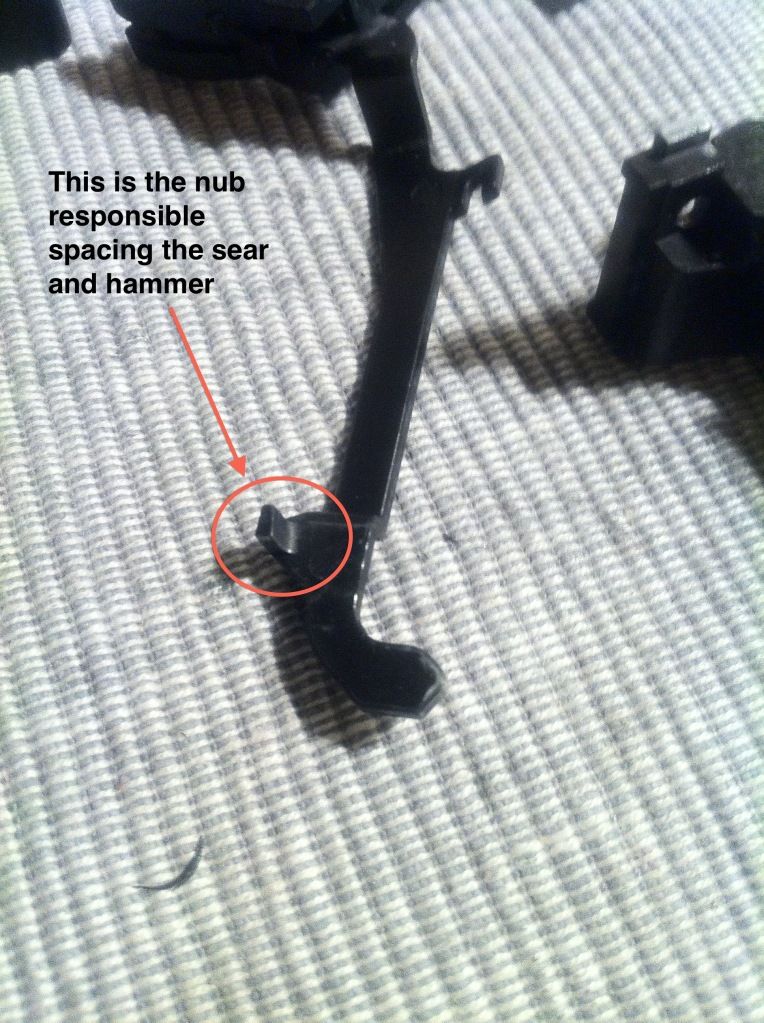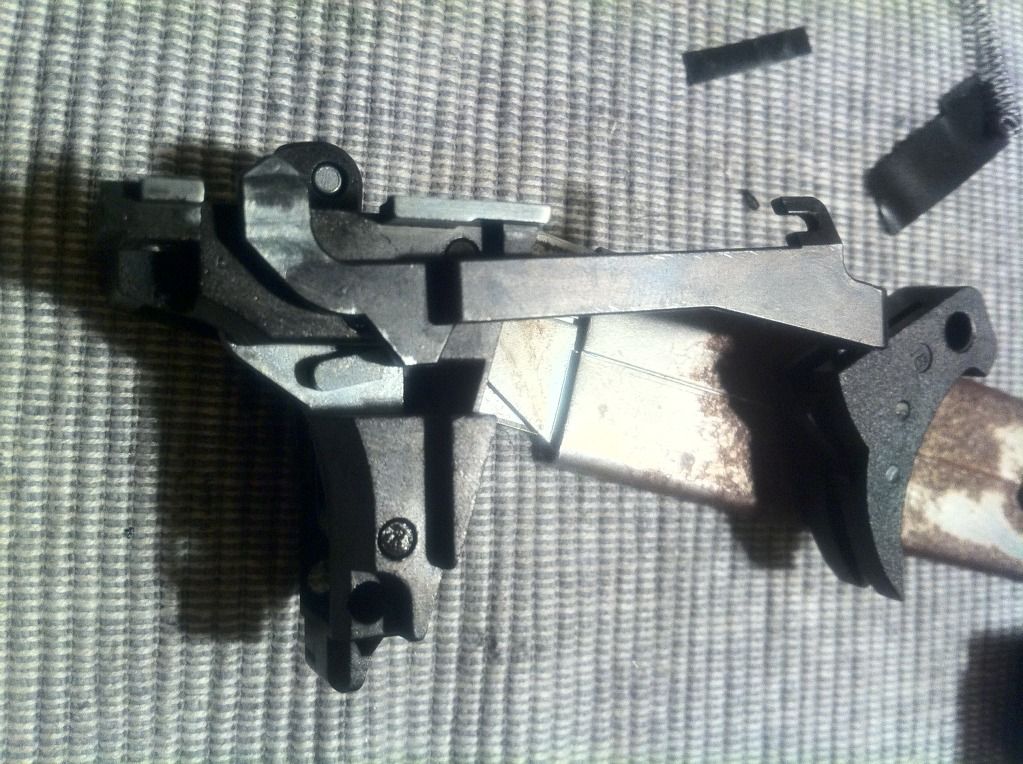Again this will get confusing so I will try to be as clear and concise as I can be.
"Blowback" explained.
Let's step back from airsoft for a moment.
Picture a sailboat in the middle of the ocean fighting against a strong current. The boat wants to move backwards but the current is moving it forwards. That sailboat will move where the current is directing it, correct?
Now let's add the element of wind going in the opposite direction of the current. Let's also say that the boat has its sails up to catch the wind and propel it backwards, where it wants to go.
If the wind is strong enough to combat the current, the boat will overpower the current and thus will move backward, where it wants to go. Now let's say that the wind has died down. Well, the current then takes the boat over again, right? So therefore the boat will "return" to same direction as the current.
This is the same science that happens inside the BBU and how it creates "blowback" or how the gun "blows" the slide backwards.
So let's replace everything in this analogy with the parts of an airsoft pistol. This equation then becomes like this:
The boat is your BBH (part g17-8) (not to be confused with "BBU", BBH is the metal casing everything is contained in)
The sail is your piston head (part g17-4 and g17-5)
The current is your recoil spring (part: g17-16)
The ocean is your WHOLE gun
The wind is the gas expelled from the magazine
So let's your in step 5B in the slide cycle (see previous post for reference) and the floating valve has closed off the airway to the BB. That part is done.
If we change the words around in my analogy, It will read something like this:
"Picture a slide/BBH in the middle of the gun fighting against a strong recoil spring. The slide/BBH wants to move backwards but the recoil spring is moving it forwards. That slide/BBH will move where the recoil spring pulls it, correct?
Now let's add the element of gas going in the opposite direction of the recoil spring. Let's also say that the BBH has its piston head up to catch the gas and propel it backwards, where it wants to go.
If the gas is strong enough to combat the recoil spring, the BBH/slide will overpower the recoil spring and thus will move backwards (or in the opposite direction of the recoil spring). Now let's say that the gas has died down. Well, the recoil spring then re-takes the BBH/Slide over again, right? and therefore slide will "return" to same direction as the recoil spring."
You can tweak the story a bit more to make it more coherent but that's the best I can do in terms of story telling. lol.
Anyways, when the floating valve closes the airway to the BB, all of the remaining gas from the magazine that didn't make it through to the BB gets channelled towards the piston head. As more gas is expelled in that direction, and provided the piston head is not busted, there is enough force is created by the current of the gas to overpower the recoil spring and physically "blow" the whole slide assembly backwards. The gas the doesn't stay in the loading muzzle strictly speaking but slowly "leaks" around the piston head or back out of the loading muzzle hole where it came from. If the gas did stay in there, the piston head and the loading muzzle will explode because of the pressure.
That is essentially what is happening inside the loading muzzle. Think of the boat!!!!!!!
The Hammer Bearing explained:
Again, I re-iterate that the function of the hammer bearing is two folds: 1). To push the hammer down so the sear can lock it 2). To cushion the hammer strike on the BBH
1) To push the hammer down so the sear can lock it
Your WE Glock is, in essence, is a Tokyo Marui design. Thus, the BBH is the same.
The design choice by Marui to incorporate a hammer bearing is quite ingenius.
Understand that the BBH, itself, can't push the hammer far enough for the sear to lock it back. Therefore, Marui incorporated the hammer bearing to perform this task. Remember the experiment I told you about? the one where you fire the gun without the bearing? try it and see what happens. You'll understand better.
How it happens is this:
There is a nub on the left side of the side of the BBH. This nub is what interacts with the hammer bearing. The nub protrudes enough so that when the hammer is down, the hammer bearing can add enough force and push the hammer further down where the sear can lock it into place.
You need the hammer bearing. If you don't want it catching to the nub, just buy s a smaller hammer bearing or round off the corner of the nub a tiny bit by filing it so that it's easier for the hammer bearing to hump over (sorta like a speed bump). After all, it's easier to get over a rounded corner than a sharp one right?
That's pretty much it. It's hard to explain without pictures so I will try for another analogy.
Suppose you are trying to hang from some monkey bars but you are too short and can't reach them. Then a magical chair appears before you. You take the chair and place beneath the monkey bars. You climb on it and boom. You're hanging off the monkey bars like the little kid you are.
The hammer bearing is the magic chair. you are the hammer and the monkey bars are the sear. Without the chair, you weren't able to reach or "lock" onto the monkey bars. Get it? heh.
Quote:
|
When you say that the hammer bearing provides a cushion to the hammer, do you mean when the trigger is pulled and the hammer is released and strikes the back of the bbu?
|
Yes.
Quote:
|
Is the small piece of plastic that screws into the nozzle just there to make sure that the floating valve does not go back to far and to direct air flow to the back?
|
This is your valve blocker. It's function is to basically make sure that the floating valve and it's holes are aligned with the hole on the loading muzzle. And like you said, it prevents the floating valve from going too far back.
Quote:
|
I noticed that on the piston in the bbu, there is a small piece of rubber attached to the bottom. What function does this piece serve?
|
If you mean the piston head, then it's function is to act as the "sail" of the slide and stops the gas from expelling backaswards.
In the stock form, the piston head has two parts: the first is the actual "sail" that traps the air inside; the second is the supporting o-ring that helps prevent damage to the sail by equalizing the strength of the surface area of the sail which the gas hits.
Quote:
|
Also yesterday when I was tinkering with the bbu, I noticed that even with the screw fully tightened for the piston head, it still wobbled a bit. I put a tiny o ring under the piston head, but the problem was still happening.
|
That's typical of any GBB, particularly WE's Hi-capa GBB pistols. Nothing much you can do unless you buy a new piston head.
Quote:
|
Oh yeah, I forgot to mention that my mags are warm to start out with, but after shooting them, they feel FREEZING, super cold, complete difference.
|
Again, there's not much you can do with that.
But I can only surmise that one of the causes is the expanding gasses flowing around your magazine when the BBU doesn't align with the air nozzle on your magazine.
In your video, you asked why the trigger bar needs a nub. The nub is needed to push the trigger bar down when the slide is cycling. If the trigger bar isn't pushed down, the sear won't lock to hammer. There is another nub beneath the nub you see facing the sear. That nub is responsible for spacing the sear apart from the hammer. Essentially, the trigger bar jams the sear so that there is no friction between the hammer and sear when the slide is is pushing the hammer down. the top nub clears the jam and the sear snaps to the hammer.

 This is when the trigger bar is "up" or the nub is "up". Notice how far the sear is and notice the little rectangular tab and how it is on a slight angle. At this point, the sear can't lock onto the hammer because it can't reach it.
This is when the trigger bar is "up" or the nub is "up". Notice how far the sear is and notice the little rectangular tab and how it is on a slight angle. At this point, the sear can't lock onto the hammer because it can't reach it.
 This is when the nub is "down". Notice the position of sear (the silver thing) and notice that the silver tab is now parallel to the trigger bar. This is when the sear is locked unto the hammer
This is when the nub is "down". Notice the position of sear (the silver thing) and notice that the silver tab is now parallel to the trigger bar. This is when the sear is locked unto the hammer
You need the top nub (the one that interacts with the slide) because in all retrospect, there is no other way to trip the trigger bar. Or there is no other place to put it where something will push it down while it simultaneously interacts with the sear.
If the trigger bar doesn't get pushed down, there will be too much space between the sear and hammer therefore the sear won't reach the hammer to lock it and thus the hammer will always stay uncocked.
If that nub is getting caught on the BBH, you can file the corner of the part of the BBH where the nub hits. Same process like you did with the hammer bearing.
If the you want to bend the trigger bar, bend the part beside the magazine chamber (the long part where nothing happens) towards the frame. DO IT VERY GENTLY AND EVeR SO VERY LIGHTLY. the trigger bar is very frail and will break in half if you bend too much too fast.
My suggestion is to come heavy with pictures of every single ppart so I can see what your set up looks like.
Did you check every single piece of your BBU for damages?